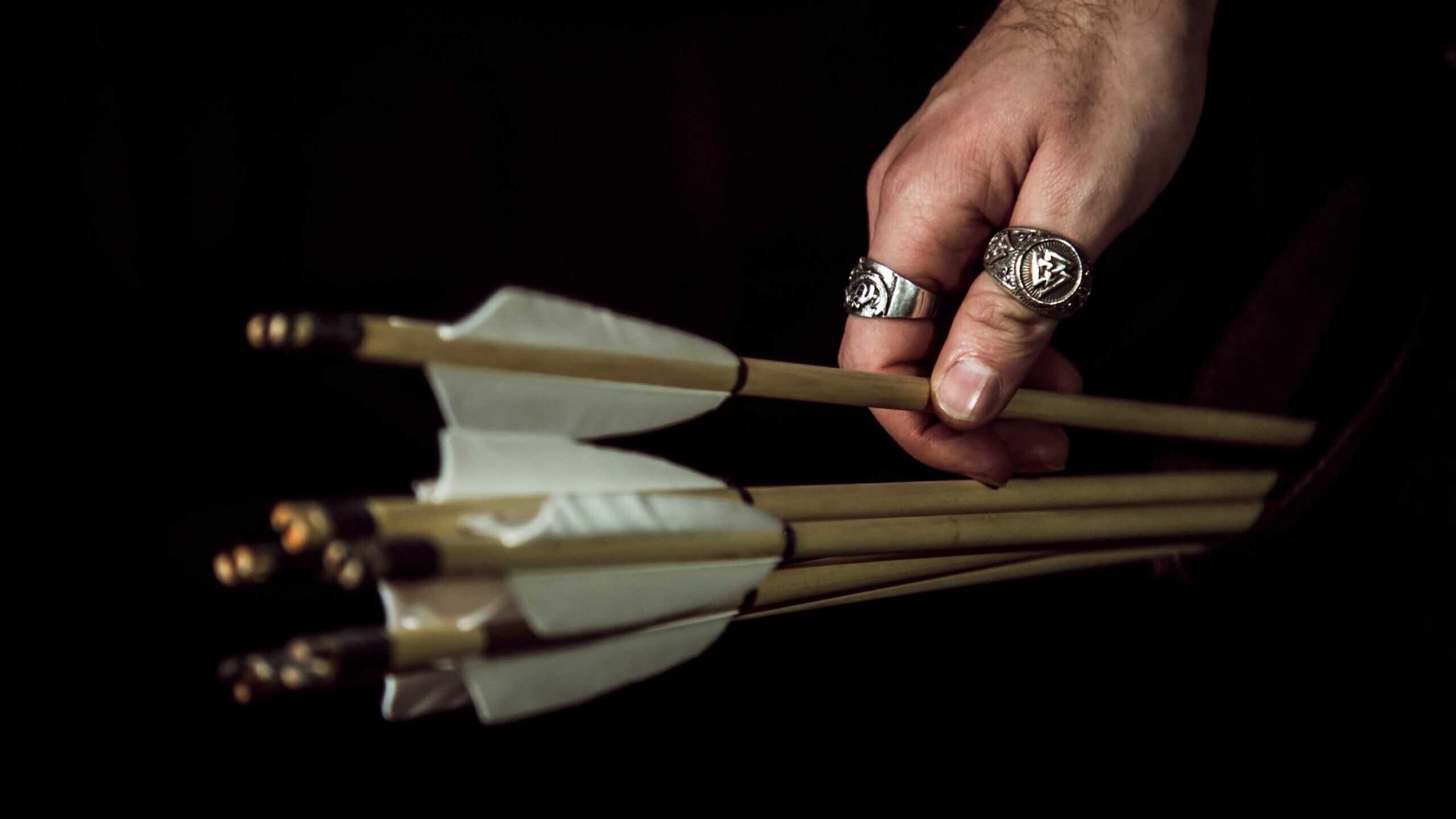The decision of which arrow is better for target practice or hunting may seem easy. But, the choice is more challenging by the variety of alternatives and variances between each arrow.
There is so much misinformation on the anatomy of an arrow, so we created this guide to clarify things and show you how to pick the best arrows for your upcoming hunting trip.
Your hunting arrows should fit your bow and the archery style you have selected, just like your bow should fit you. You can choose the best arrows by being aware of the different parts.
So, in this article, we are going to look at the various parts of an Arrow.
What is an Arrow?
An arrow is a projectile with fin stabilization that is fired by a bow. It has numerous important components that together, form a solid projectile. One way to think of a modern arrow is as its point’s delivery mechanism. This is everything you need to know about arrow in archery.
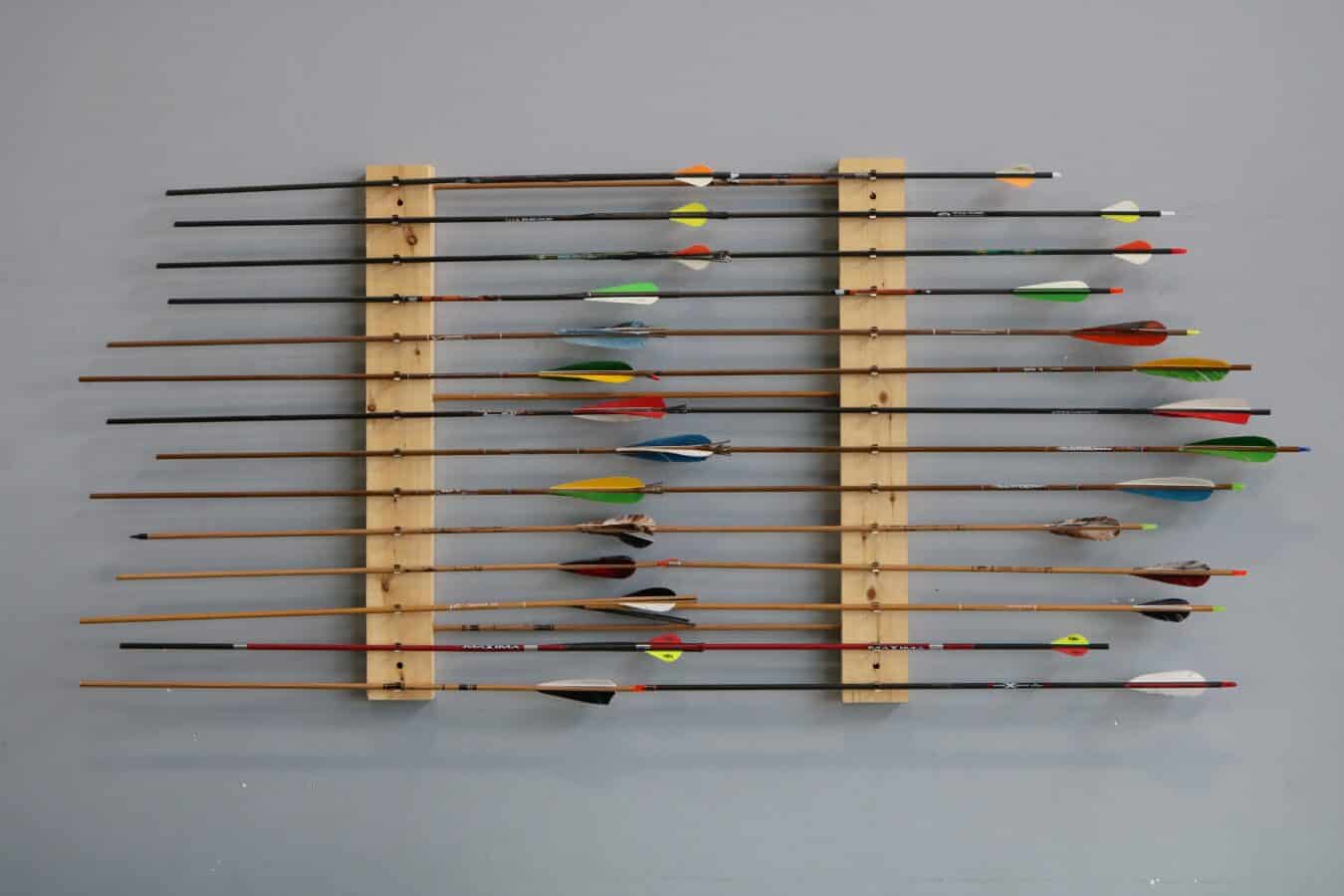
Parts of an Arrow
There is a lot more going on when you look closely at the anatomy of an arrow. What are arrows made of? That is the pending question. Each component of an arrow has a particular purpose and is available in a wide range of shapes, weights, colors, and materials. The arrow parts diagram is shown below;
You should be aware of the four primary arrow parts’ names which are point, shaft, fletching, and nock. For you to be able to shoot arrows precisely, each of these components functions as a unit. We will outline the different parts and describe how each arrow component differs from the others.
Point
The arrow’s point is cutting edge, and depending on what you’re hunting, it might have different properties. What you should know is that each arrow point flies differently. Field points and broadheads often differ the most since you can shoot them from a greater distance than other weapons.
In the past, archers used the tip of the arrow to aim an arrow at a target before the development of contemporary bow sights.
Within each point-type category, there are several weights and shapes of arrow points. The majority of arrow points screw into the arrow shaft, whether you use them for target practice or small game hunting.
Below are the types of arrow points;
1. Mechanical Broadheads: Because they are folded inside the head, these blades create less drag when flying. In comparison to fixed blade broadheads, the blades immediately expand upon impact, cutting a significantly bigger surface and creating a wider wound channel. These broadheads call for a heftier bow, at least one that weighs 50 lbs. Check out this hunting Broadhead product on Amazon.
2. Fixed Blade Broadheads: Fixed broadheads, as the name implies, have blades that are “fixed” into place on the ferrule and never deploy or move. The advantages of this style of head are better penetration, a generally stronger/tougher construction, and a reduced risk of malfunction. You can be attached Fixed blade broadheads to an arrow shaft directly with adhesive or by the use of an insert, depending on the style.
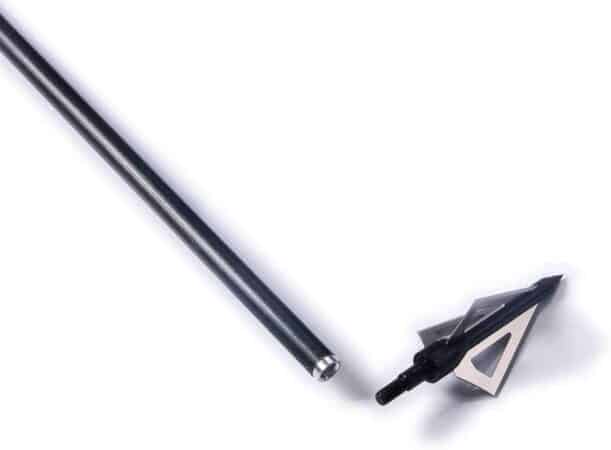
3. Judo Points: These unique points, which resemble springs, cause the arrow to fly straight up. So, using these points when shooting in grassy or brushy terrain helps to reduce arrow loss. Also, Judo points are often used for hunting small animals.
4. Field Points: These points, which have a wide shoulder towards their base, are among the most popular varieties used for target practice and hunting small game. Arrows won’t get trapped in the target as a result of this. They provide more accuracy and penetration than other points.
Shaft
The bulk of the actual arrow is the arrow shaft. Modern arrows have arrow shafts constructed of fiberglass, carbon fiber, aluminum, or a mix of carbon and aluminum in addition to their traditional wood construction.
For compound bows‘ greater speeds, you shouldn’t use wooden arrows. It is preferable to use lightweight carbon arrows or aluminum arrows.
The arrow spine is a crucial feature to consider when thinking about arrow shafts, irrespective of the materials. So, you can use the spine to measure the flex or bend of an arrow.
However, your draw weight, the length of the arrow shaft, and the weight of the arrow tip will determine the spine rating to use.
The precision of your shots is directly impacted by matching the arrow spine to your precise hunting setup.
Ultimately, the kind of bow you will be shooting will primarily dictate the material you use for the arrow shaft and spine.
Fletching
Feathers or plastic vanes are the most popular forms of arrow fletching, however, they come in numerous lengths and shapes. So, what’s the purpose of the fletching? Fletchings are made to correct any minor flaws that cause the arrow to fly in an unintended direction after it has been shot out of a bow.
Below are styles of arrow fletching;
1. Feathers: Natural feathers provide a more steady flying because they have a better “grip” in the air. What are feathers on an arrow? The majority of arrow feathers are plucked from the tail or the tip of the wing because they are big and sturdy.
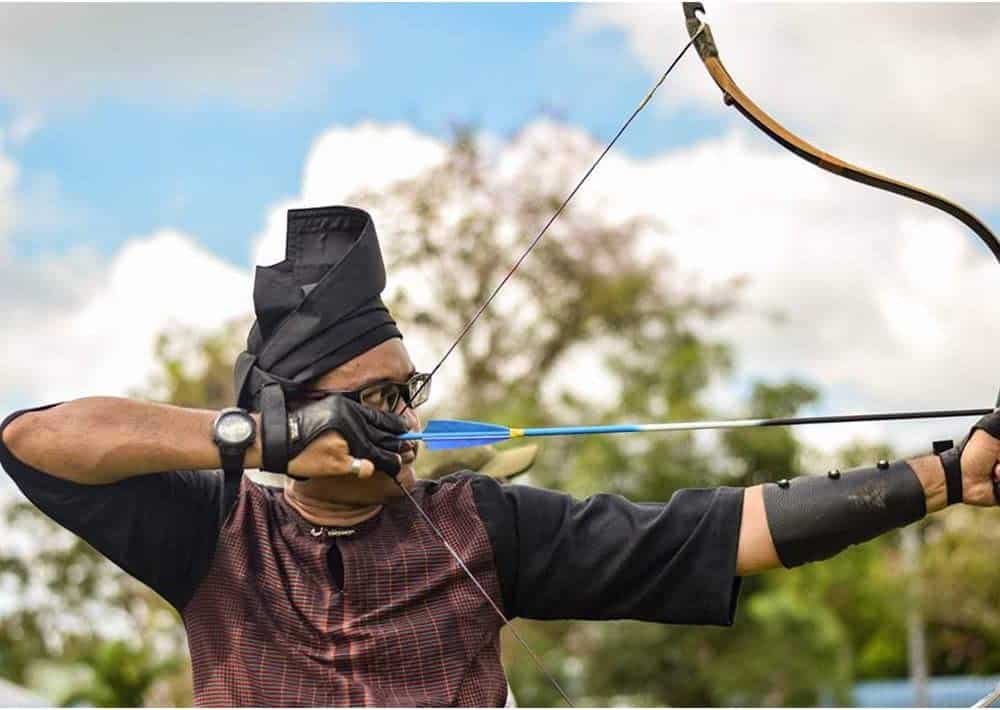
2. Vanes: Vanes are plastic feathers, which are often smaller than real feathers. They enable the arrow to accelerate more quickly.
Check out this arrow fletching product on Amazon.
Nocks
On the back of the arrow, there is a slotted plastic tip called a “nock” that connects to the string and stabilizes the arrow. You can nock your arrows at a certain location on the bowstring known as the “nocking point.” It is typically necessary to adjust this spot by sliding it up or down the bowstring.
Below are the types of arrow nocks;
1. Lighted nocks: These aren’t necessarily a new kind of arrow nock; rather, they’re a potential extra feature. These nocks often include a tiny LED light inside either press-fit or over-nock designs. When used, they will illuminate, giving an archer a greater view of the flight path of their arrow. Due to their ability to watch how their arrows affect an animal, bowhunters use this nock.
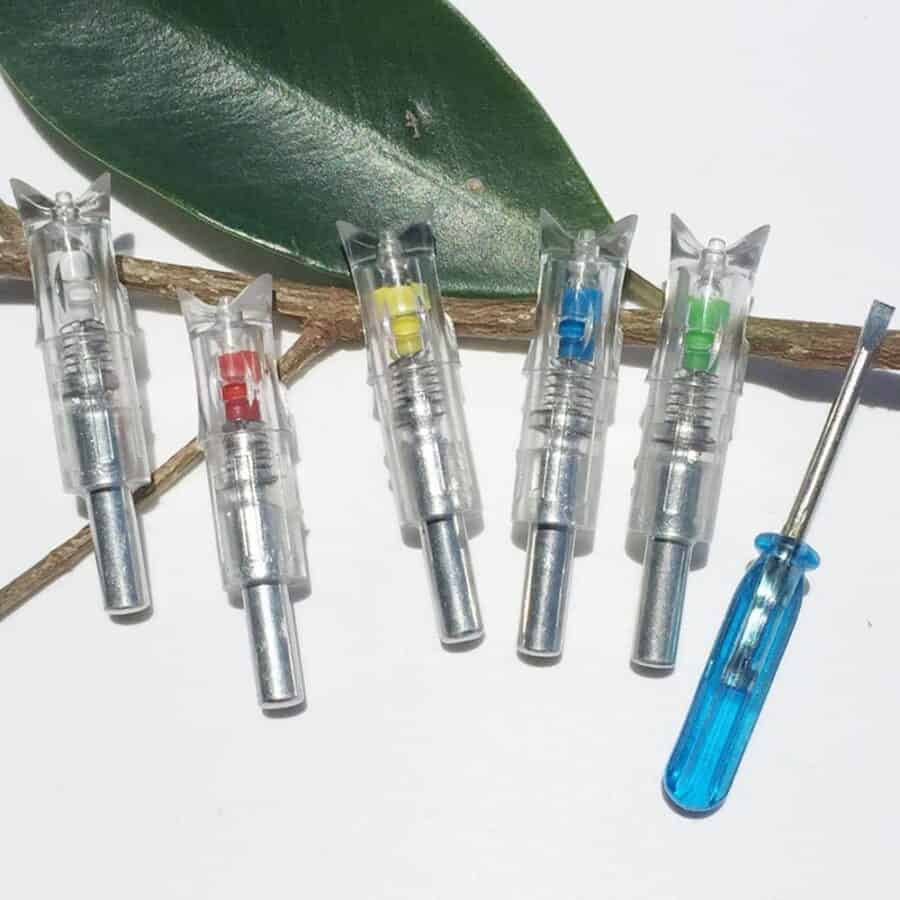
2. Overnocks: In contrast to press-fit or pin-nocks, which are attached to the inside of the arrow shaft, overnocks glide over the shaft as they sound. Usually, they are cemented on as well. You can use Overnocks with big-diameter carbon arrows as well as wooden arrows.
3. Press-fit nocks: This nock might be one of your best encounters. You can use all types, dimensions, and diameters of arrow shafts with them, except for the thinnest carbon shafts. Press the nock into the shaft to be installed, as suggested by its name. The primary part of the nock should come into touch with the end of the arrow shaft as you slide the post within and push it in.
4. Pin nocks: Pin nocks are tiny nocks that are intended to attach to an aluminum pin that is inserted into the shaft end of an arrow. When other arrows strike an arrow shaft, this kind of arrow nock is intended to prevent damage. Since all pins are produced in the same standard size, these nocks also have the significant advantage of fitting any pin insert.
Check out this arrow-nock product on Amazon.
How do you measure Arrow Length?
The distance between the rear of the tip and the nock’s throat is the accepted measurement for arrow length. Your arrow length will depend on your draw length and arrow spine. Your arrow length would be around 27 inches if you have a draw length of 28 inches and want it to terminate at the front of the bow riser.
If you need to make your arrow’s spine weaker, the length of the arrow can be increased. Keep your arrows from being too short for safety’s sake.
What does an arrow’s spine look like?
You can measure the flex or bend of the arrow’s “spine.” Manufacturers assign a number to each arrow shaft and arrange them according to the spine dimensions. The spine number is written on the arrow’s label. 350, 400, 500, and 600 are a few frequent figures, however, manufacturers use different amounts.
What is the name of an arrow’s two ends?
The Throat and the Groove. Two posts on each nock are referred to as the ears, and they taper inward to the string aperture. The throat is the tapering portion, and you can position the groove in the string.
Conclusion
The ideal arrows for your hunting setup depend on a variety of factors, from the arrow nock to the arrow point.
Your arrows must be properly built and adjusted to your specific bow anatomy setup, whether they include wood or aluminum shafts, feathers for fletching, or lighted-nocks. It’s essential for taking ethical, clean shots in the hunting game.
With this article, we hope you now have a clearer grasp of the four parts of an arrow.
